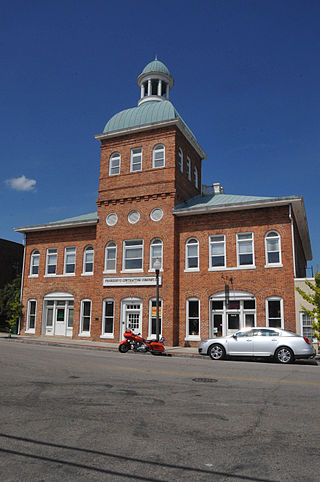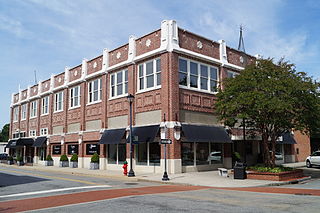
Belmont is a small suburban city in Gaston County, North Carolina, United States, located about 13 miles (21 km) west of uptown Charlotte and 9 miles (14 km) east of Gastonia. The population was 10,076 at the 2010 census. Once known as Garibaldi Station, it was named for the New York banker August Belmont. Belmont is home to Belmont Abbey College.

College Hill is a neighborhood in the west central section of the United States city of Greensboro, North Carolina. College Hill was Greensboro's first neighborhood.

Valparaiso has retained an active downtown. It remains a mix of government, retail and business center, with a mixed residential and service area. Numerous economic changes have not changed the basic character, historic courthouse area. The historic district retains the distinctive turn-of-the-19th-century architecture, supporting numerous small specialty shops, shaded sidewalks, and a people friendly environment. The Downtown District, is anchored on the Porter County Courthouse. It includes 14-blocks surrounding the square, bounded on the north by Jefferson Street, on the east by Morgan Street, on the south by Monroe Street, and on the west by Napoleon Street.

Downtown Buckhannon Historic District is a national historic district located at Buckhannon, Upshur County, West Virginia. It encompasses 57 contributing buildings and one contributing structure that include the civic and commercial core of Buckhannon. Most of the buildings in the district date from the late-19th and early-20th century in popular architectural styles, such as Italianate, Queen Anne, Colonial Revival, and Classical Revival. Notable buildings include the Presbyterian Church on Locust Street (1879), T. L. Stockert Building (1908), Peoples Bank Building (1910), Upshur County Court House, and U.S. Post Office (1916).

Mooresville Historic District is a national historic district located in Mooresville, Iredell County, North Carolina. It encompasses 62 contributing buildings and 8 contributing sites in the central business district and surrounding residential sections of Mooresville. The district includes notable examples of Italianate, Romanesque Revival, and Renaissance Revival architecture. Notable buildings include the Mooresville depot, the former Lorene Cotton Seed Oil Mill, First Presbyterian Church (1899), McLelland House, D. E. Turner Hardware Co. store, the former U. S. Post Office, and the McKnight Pontiac-Buick Co..

Black Mountain Downtown Historic District is a national historic district located at Black Mountain, Buncombe County, North Carolina. The district encompasses 56 contributing buildings and 1 contributing structure in the central business district of Black Mountain. The district includes a variety of late-19th and early-20th century commercial and institutional buildings in the Commercial Style, American Craftsman, Classical Revival, Art Deco and Art Moderne. Notable buildings include the George Stepp House (1907), Black Mountain Depot (1909), firehouse (1921) designed by Richard Sharp Smith, town hall (1927), Kaltman Building (1928), and Pure Oil Service Station.
Downtown Asheville Historic District is a national historic district located at Asheville, Buncombe County, North Carolina. The district encompasses about 279 contributing buildings and one contributing object in the central business district of Asheville. It includes commercial, institutional, and residential buildings in a variety of popular architectural styles including Colonial Revival, Queen Anne, and Art Deco.

Morganton Downtown Historic District is a national historic district located at Morganton, Burke County, North Carolina. It encompasses 62 contributing buildings in the central business district of Morganton. It includes commercial, industrial, and governmental buildings built between about 1889 and 1940. It includes representative examples of Classical Revival, Art Deco, and Italianate style architecture. Notable buildings include the Old Burke County Courthouse, Morganton Post Office, and the Morganton Community House.

Lenoir Downtown Historic District is a national historic district located at Lenoir, Caldwell County, North Carolina. The district includes 41 contributing buildings and 2 contributing objects in the central business district of Lenoir. It includes commercial, governmental, and institutional buildings in a variety of popular architectural styles including Art Deco, Art Moderne, Classical Revival and Tudor Revival. Notable contributing resources include the Center Theater (1941), O. P. Lutz Furniture Company and Lutz Hosiery Mill (1939), Dayvault's Drug Store (1937), Caldwell County Agricultural Building (1937), Courtney Warehouse, Masonic Hall, Miller Building, Confederate Monument (1910), Belk's Department Store (1928), Lenoir Building (1907), J. C. Penney Department Store, Fidelity Building (1928), and U. S. Post Office (1931). Located in the district is the separately listed Caldwell County Courthouse.

Downtown Gastonia Historic District is a national historic district located at Gastonia, Gaston County, North Carolina. It encompasses 77 contributing buildings and 1 contributing object in the central business district of Gastonia. The commercial, civic, institutional, and multi-unit residential buildings were built between the 1890s and 1954, and include notable examples of Colonial Revival and Classical Revival architecture. Located in the district are the separately listed former Gaston County Courthouse, First National Bank Building, Third National Bank Building, and Robinson-Gardner Building. Other notable buildings include the U.S. Post Office (1935), York Medical Building (1938), Kress Department Store, Leibowitz Department Store, Ideal Moving Picture Theater, City Hall, Kirby Building (1922), First Baptist Church (1922), Gaston County War Memorial Hall (1928), and the (former) Gaston County Public Library (1930).

Weldon Historic District is a national historic district located at Weldon, Halifax County, North Carolina. It encompasses 256 contributing buildings, 2 contributing structures, and 9 contributing structures in the central business district and surrounding residential sections of the town of Weldon. The district includes notable examples of Queen Anne, Colonial Revival, and Bungalow / American Craftsman style architecture. The district overlaps the Roanoke Canal Historic District. Notable buildings include the Larkin-Hart House, Ashley L. Stainback House c. (1879), Smith-Dickens House (1901-1902), DeLeon F. Green House (1934) designed by William Lawrence Bottomley, Emry-Zollicoffer Building (1877), Bank of Weldon Building, George C. Green Building/Bank of Halifax Building (1915), Weldon Grocery Company Building (1913), (former) Weldon Town Hall (1893), United States Post Office (1938), Weldon Freight Depot, Coca-Cola Bottling Company (1925), and Atlantic Coast Line Railroad Embankment and Viaduct.

Ahoskie Downtown Historic District is a national historic district located at Ahoskie, Hertford County, North Carolina. The district encompasses 14 contributing buildings in the central business district of Ahoskie. The commercial and governmental buildings include notable examples of Classical Revival and Colonial Revival architecture dated between 1901 and the late 1930s. Notable buildings include the (former) United States Post Office (1940), Garrett Hotel (1926), W. D. Newsome Building, Hotel Comfort (1907), Mitchell Hotel, Hertford Herald building, Bank of Ahoskie (1925-1926), Sawyer~Browne Furniture Company (1924), Richard Theater (1927), and E. L. Garrett Building (1938).

Downtown Sanford Historic District is a national historic district located at Sanford, Lee County, North Carolina. It encompasses 53 contributing buildings in the central business district of Sanford. The district includes notable examples of Colonial Revival, Tudor Revival and Art Deco style architecture, with buildings largely dated between about 1895 to 1930. Located in the district are the separately listed Railroad House and Temple Theatre. Other notable buildings include the Sanford Buggy Company, McCracken Building, Passenger Depot, City Hall, Coca-Cola Bottling Company, Masonic Lodge, Makepeace Building (1924), Wilrick Hotel (1925), Bowers Building, Cole Pontiac Building, Hubbards Shoe Store (1926), Carolina Hotel (1930), and former U. S. Post Office.

Greenville Commercial Historic District is a national historic district located at Greenville, Pitt County, North Carolina. The district encompasses 51 contributing buildings in the central business district of Greenville. It includes buildings dated from about 1914 to 1952 and notable examples of Greek Revival and Queen Anne style architecture. Located in the district and listed separately are the Pitt County Courthouse (1911) by Milburn, Heister & Company and U.S. Post Office (1913). Other notable buildings include the Proctor Hotel (1911), Montgomery Ward Department Store (1929), Dail-Hodges Building (1919), Blount Building (1924), Greenville Bank and Trust, Smith Electric Building, Greenville Municipal Building (1929) designed by Benton & Benton, Blount-Harvey Department Store (1923), White's Theater (1914), Charles Greene House (1860), and the Robert Lee Humber House (1895).

Main Street Commercial Historic District is a national historic district located at Hamlet, Richmond County, North Carolina. The district encompasses 23 contributing buildings, 3 contributing structures, and 1 contributing object in the central business district of Hamlet. It includes buildings built between about 1900 to about 1940 and notable examples of Queen Anne, Art Deco, and Classical Revival architecture. Located in the district is the separately listed Seaboard Air Line Passenger Depot. Other notable buildings include the Terminal Hotel, Union Building, the Bank of Hamlet (1912), the Old Hamlet Opera House, and the U.S. Post Office (1940), a Works Progress Administration project.

Reidsville Historic District is a national historic district located at Reidsville, Rockingham County, North Carolina. It encompasses 324 contributing buildings, 1 contributing site, 11 contributing structures, and 1 contributing object in the central business district and surrounding residential sections of Reidsville. It was developed between about 1865 and 1941, and includes notable examples of Italianate, Queen Anne, American Craftsman, and Classical Revival style architecture. Located in the district are the separately listed Penn House and Gov. David S. Reid House. Other notable buildings include the Oaks-Motley House, Colonel A. J. Boyd House (mid-1870s), Reid Block (1880s), Citizens' Bank Building, William Lindsey and company Tobacco Factory, First Baptist Church, Main Street Methodist Church, Melrose (1909) designed by architect Richard Gambier, R. L. Watt house designed by Willard C. Northup, First Presbyterian Church (1922), St. Thomas Episcopal Church, Grand Theatre, Belvedere Hotel, United States Post Office and Federal Building, and the Municipal Building (1926).

Richardson Houses Historic District is a national historic district located at Reidsville, Rockingham County, North Carolina. It encompasses 17 contributing buildings and 2 contributing structures in a residential section of Reidsville. It was developed between about 1840 and 1912, and includes notable examples of Italianate, Greek Revival, and Classical Revival style architecture. The three principal buildings in the district are the Robert Payne Richardson House I, the Robert Payne Richardson House II, North Belmont, and the Robert Payne Richardson House III, Belmont (1912).

Salisbury Historic District is a national historic district located at Salisbury, Rowan County, North Carolina. The district encompasses 348 contributing buildings and 1 contributing site in the central business district and surrounding residential sections of Salisbury. It includes notable examples of Late Victorian, Colonial Revival, and Bungalow / American Craftsman style architecture. Located in the district are the separately listed Maxwell Chambers House, McNeely-Strachan House, Archibald Henderson Law Office, and the former Rowan County Courthouse. Other notable buildings include the tower of the former First Presbyterian Church (1891-1893), Rowan County Courthouse (1914), Conrad Brem House, Kluttz's Drug Store, Bell Building, Washington Building, Grubb-Wallace Building, Hedrick Block, Empire Hotel, St. Luke's Episcopal Church (1827-1828), Soldiers Memorial A.M.E. Zion Church (1910-1913), U.S. Post Office and Courthouse (1909), City Hall (1926), Salisbury Fire House and City Building (1897).

Plymouth Downtown Historic District is a national historic district located in Plymouth, Marshall County, Indiana, United States. The district encompasses 47 contributing buildings and one contributing structure in the central business district of Plymouth. It developed between about 1870 and 1940, and includes examples of Italianate, Romanesque Revival, and Colonial Revival style architecture. Located in the district is the separately listed Plymouth Fire Station. Other notable buildings include the Montgomery Ward Building (1929), Metsker Block, Rentschler Building (1910), Early Plymouth Post Office (1884), First National Bank-Plymouth City Hall, Packard Bank Block (1879), Simons Building (1895), Wheeler Block, Bank Block, Bank Block-Masonic Temple (1901), Plymouth Post Office (1935), and Plymouth Motor Sales (1929).

Downtown Webb City Historic District is a national historic district located at Webb City, Jasper County, Missouri. The district encompasses 43 contributing buildings in the central business district of Webb City. It developed between about 1883 and 1965 and includes representative examples of Italianate, Renaissance Revival, Romanesque Revival, Art Deco, and Streamline Moderne style architecture. Located in the district is the previously listed Middle West Hotel. Other notable buildings include the National Bank, S. Morris Department Store, Morris Opera House and Royal Furniture Co., The Unity Building and Merchant and Miners Bank, Aylor Building / Odd Fellow Hall, Mystic Theater, Newland Hotel, Dickenson Theater, Civic Theater, U.S. Post Office, and the Old U.S. Post Office / Wagner Building.



























